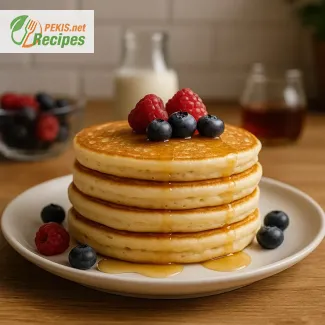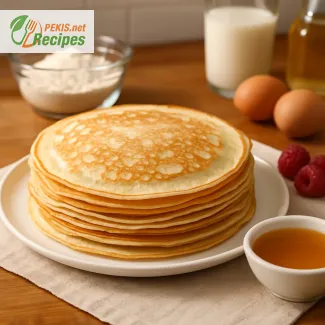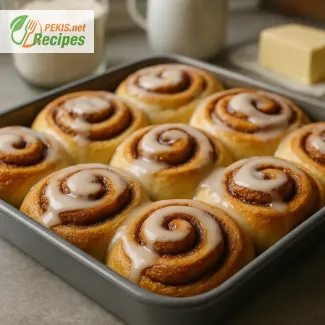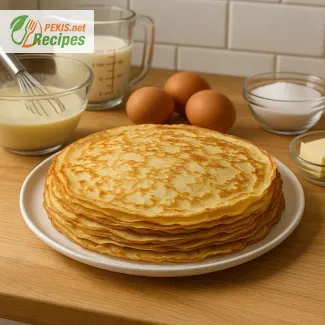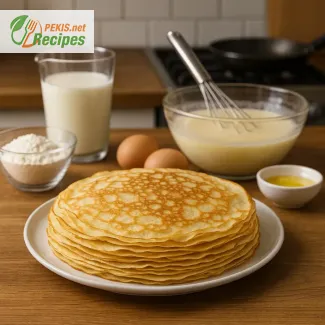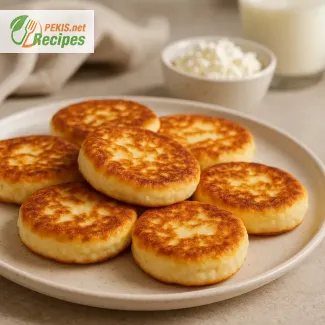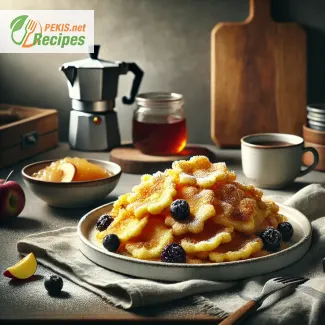
Kaiserschmarrn Recipe – A Delightful Austrian Classic
The Magic of Kaiserschmarrn
Few dishes can evoke the warmth and comfort of Kaiserschmarrn, a beloved Austrian specialty that has stood the test of time. This fluffy, torn pancake is more than just a dessert—it is a culinary experience that brings people together, whether enjoyed as a sweet main course or a hearty snack. Its golden-brown exterior, combined with its airy interior, makes every bite a delightful contrast of textures, while the light dusting of powdered sugar adds the perfect finishing touch.
The origins of Kaiserschmarrn are deeply rooted in Austrian tradition, with its name meaning "Emperor's Mess", a tribute to Emperor Franz Joseph I, who was reportedly a great fan of this dish. Over the years, it has found its way into the hearts of food lovers worldwide, celebrated for its simplicity, elegance, and irresistible flavor.
The Perfect Balance of Texture and Flavor
The charm of Kaiserschmarrn lies in its unique preparation and versatile serving options. Unlike traditional pancakes, it is cooked as a large, thick layer before being torn into bite-sized pieces, creating a wonderful balance of crispy edges and soft, fluffy centers. This variation in texture is what makes it truly special—every forkful offers a mix of light, caramelized bites paired with delicate, melt-in-your-mouth softness.
The subtle sweetness of the batter, combined with vanilla and a hint of rum-soaked raisins, gives Kaiserschmarrn a distinctive depth of flavor. The buttery, golden crust, achieved by caramelizing the pancake in the pan, enhances its richness, while the gentle sweetness of powdered sugar balances the flavors perfectly.
A Versatile Treat for Every Season
Kaiserschmarrn is a dish that transcends seasons, making it an ideal choice for any time of the year. In winter, it is often served with warm plum compote or apple sauce, creating a cozy, nostalgic feel. The combination of warm, soft pancake pieces with fruity accompaniments adds a comforting, homely touch that is perfect for cold evenings.
During spring and summer, it pairs beautifully with fresh berries, light citrus zest, or even a scoop of vanilla ice cream, offering a refreshing, vibrant twist. The mild sweetness of the pancake allows it to complement a variety of flavors, from rich and creamy to tangy and fresh.
This versatility makes Kaiserschmarrn a staple in Austrian mountain lodges, cafés, and family kitchens, enjoyed by both locals and tourists alike. Whether served in a traditional wooden chalet after a day of skiing or on a sunlit terrace in summer, it remains an undeniable crowd-pleaser.
The Secret to a Perfect Kaiserschmarrn
While the ingredients for Kaiserschmarrn are simple and readily available, achieving the perfect texture requires a few key techniques. The airiness of the pancake is what sets it apart, and this can be enhanced by separating the eggs and whipping the egg whites to soft peaks before folding them into the batter. This step creates a light, cloud-like consistency, ensuring the final dish is soft and fluffy rather than dense.
Another essential factor is the cooking process. Kaiserschmarrn is best cooked slowly over medium heat, allowing the batter to rise and cook evenly. Instead of flipping it in one go, the pancake should be gently torn apart with two forks, creating irregular, golden-brown pieces that crisp up beautifully in the pan. A final touch of butter and sugar helps to caramelize the pieces, enhancing their rich, buttery flavor.
Traditional and Modern Variations
While the classic Kaiserschmarrn remains a favorite, there are several delicious variations that offer unique twists on this timeless dish.
- Nutty Kaiserschmarrn: Adding chopped almonds or hazelnuts to the batter introduces a delightful crunch and depth of flavor.
- Chocolate Kaiserschmarrn: A touch of cocoa powder or chocolate chips brings a richer, more indulgent experience.
- Coconut Kaiserschmarrn: For a tropical touch, coconut milk can be used instead of dairy milk, and a sprinkle of toasted coconut flakes adds extra flavor.
- Gluten-Free Kaiserschmarrn: A mixture of almond flour and gluten-free baking flour ensures that everyone can enjoy this Austrian delicacy without compromising on taste or texture.
A Delight for All Ages
One of the most charming aspects of Kaiserschmarrn is its universal appeal. It is a dish that is equally loved by children and adults, bringing a sense of nostalgia and indulgence with every bite. For many, it is a cherished family recipe, passed down through generations, evoking fond memories of cozy winter evenings or sunlit weekend brunches.
Whether you are a fan of traditional Austrian cuisine or simply looking for a deliciously comforting dish, Kaiserschmarrn is a must-try. Its simplicity, adaptability, and rich history make it a standout choice for any occasion.
Kaiserschmarrn is more than just a dish—it is an experience. Its light, fluffy texture, combined with rich caramelized edges and a variety of delicious toppings, makes it a timeless favorite that can be enjoyed year-round. Whether served in a rustic mountain lodge or made fresh in your own kitchen, it remains a true comfort food classic that brings joy with every bite.
- Prepare the batter: In a bowl, mix milk, flour, sugar, salt, and vanilla sugar until smooth. Separate the eggs. Stir the yolks into the batter. In a separate bowl, beat the egg whites until stiff peaks form, then gently fold them into the batter to keep it airy.
- Cook the Schmarrn: Melt the butter in a large pan over medium heat. Pour in the batter, spreading it evenly. Optionally, sprinkle raisins on top.
- Let it set and tear apart: Once the bottom turns golden brown (after about 4–5 minutes), cut the pancake into quarters and flip each piece. Cook for another 3–4 minutes. Then, use two forks to tear it into bite-sized pieces.
- Caramelize: Add a little more butter and sugar to the pan, letting the pieces caramelize for a richer flavor.
- Serve: Dust with powdered sugar and serve warm with applesauce or plum compote.
The Perfect Kaiserschmarrn – A Culinary Delight
The Unique Charm of Kaiserschmarrn
Kaiserschmarrn is more than just a pancake variation—it is an Austrian classic that has won hearts worldwide. This fluffy, shredded pancake, lightly caramelized in butter and dusted with powdered sugar, is a dish that balances sweetness, texture, and indulgence perfectly. Traditionally enjoyed in alpine huts or at home with family, this dish is both simple and elegant, making it ideal for breakfast, brunch, or even as a comforting main course.
Unlike standard pancakes, Kaiserschmarrn has a unique preparation method. Instead of flipping it whole, it is torn into bite-sized pieces, giving it an irregular yet inviting texture. The golden-brown, crispy edges contrast with the soft, airy interior, creating a delightful balance in every bite. The dish is often paired with fruity accompaniments like plum compote, applesauce, or berry preserves, enhancing its overall depth of flavor.
How to Achieve the Best Kaiserschmarrn
Perfecting Kaiserschmarrn requires a balance of ingredients, technique, and cooking precision. Each component plays a crucial role in determining the fluffiness, caramelization, and taste of the final dish.
The Right Flour for the Ideal Consistency
The choice of flour affects both the texture and flavor of Kaiserschmarrn. All-purpose wheat flour (Type 405 or 550) is commonly used, as it provides the right structure while keeping the pancake light.
- More flour: Results in a denser texture, making the dish heartier but less airy.
- Less flour: Produces a softer texture but may make the batter too runny, leading to uneven cooking.
- Alternative flours: Dinkel (spelt) flour adds a mild nutty note, while gluten-free blends ensure the dish remains accessible for those with dietary restrictions.
The Role of Eggs in Fluffiness
Eggs are fundamental to achieving the iconic light texture of Kaiserschmarrn. Separating the yolks from the whites and whipping the egg whites into stiff peaks before folding them into the batter ensures that the final dish is airy and soft.
- More eggs: Enhances the richness and deepens the golden color.
- Less eggs: Results in a flatter texture, making the dish less fluffy.
- Egg substitutes: For an egg-free version, mashed bananas (50 g per egg) or a flaxseed-water mixture (1 tbsp flaxseed + 3 tbsp water per egg) can be used.
The Importance of Milk
Milk adds moisture, richness, and creaminess to the batter. Whole milk (3.5% fat) is the preferred choice, but adjustments can be made based on dietary needs.
- More milk: Leads to a thinner batter, making the Kaiserschmarrn more delicate.
- Less milk: Creates a thicker batter, resulting in a heartier and more robust texture.
- Plant-based milk: Almond milk introduces a slight nuttiness, oat milk enhances creaminess, and coconut milk brings a subtle tropical touch.
Sugar for Sweetness and Caramelization
Sugar influences both flavor and texture in Kaiserschmarrn. A moderate amount in the batter provides a light sweetness, while a final sprinkle in the pan encourages golden caramelization.
- More sugar in batter: Produces a sweeter result but can cause quicker browning.
- Less sugar: Reduces sweetness, making it more adaptable for fruit toppings.
- Caramelization technique: A small amount of butter and sugar added in the final minutes of cooking ensures a lightly caramelized, glossy finish.
Enhancing Flavor and Texture
Although the classic recipe is already delicious, there are numerous ways to enhance the flavor and texture by adding different ingredients.
Flavor Additions
- Vanilla extract or vanilla sugar: Enhances the natural sweetness and gives a more aromatic profile.
- Cinnamon: Introduces a warm, slightly spicy note, making it ideal for autumn and winter variations.
- Citrus zest (lemon or orange): Provides a fresh, tangy contrast that balances the richness of the dish.
- Nutmeg: A pinch adds a slightly earthy undertone, deepening the complexity of flavors.
Texture Enhancements
- Rum-soaked raisins: Traditional in Austrian Kaiserschmarrn, these add a boozy depth and chewy texture.
- Chopped almonds or hazelnuts: Introduce a subtle crunch, making the dish more dynamic.
- Shredded coconut: Adds a mild sweetness and enhances texture without overwhelming the classic taste.
Serving Ideas and Perfect Pairings
Kaiserschmarrn is best enjoyed fresh, but its experience is elevated when served with complementary sides and toppings.
Traditional Accompaniments
- Applesauce: A mild and fruity side that balances the caramelized sweetness.
- Zwetschgenröster (plum compote): Offers a slightly tart contrast that pairs beautifully with the rich pancake pieces.
- Vanilla sauce: A creamy addition that enhances indulgence.
- Berry compote: Fresh or cooked berries add natural acidity that cuts through the sweetness.
Creative Twists
- Chocolate Kaiserschmarrn: Adding dark chocolate shavings or cocoa powder results in a rich, dessert-like experience.
- Berry-infused: Fresh raspberries or blueberries folded into the batter before cooking create pockets of juicy flavor.
- Savory variation: Reducing sugar and adding herbs, cheese, or sautéed mushrooms transforms Kaiserschmarrn into a unique savory dish.
Expert Tips for a Flawless Kaiserschmarrn
Achieving the perfect texture and ideal caramelization requires attention to detail.
- Whip the egg whites separately: This step is crucial for an airy, cloud-like texture.
- Use a well-buttered pan: Ensuring the pan is properly greased prevents sticking and aids in even browning.
- Cook over medium heat: Avoid high heat, which can lead to overcooking on the outside while leaving the center underdone.
- Flip and tear at the right time: Wait until the base is golden brown before breaking it apart, ensuring a well-developed crust.
- Caramelize for extra flavor: Adding a final touch of butter and sugar in the last few minutes elevates the dish’s depth and texture.
Kaiserschmarrn is a dish that captures the essence of Austrian cuisine—simple, yet incredibly satisfying. Its delicate fluffiness, caramelized edges, and versatile pairings make it an unforgettable treat for any occasion. Whether you prefer the classic version or enjoy customizing it with unique ingredients, this dish remains a delightful, heartwarming experience that is sure to impress every time.
- Contains gluten (flour), milk, eggs.
- May cause lactose and wheat intolerance reactions.
Substitutions for allergies:
- Gluten-free: Replace wheat flour with gluten-free flour (e.g., buckwheat or almond flour).
- Lactose-free: Use plant-based milk (e.g., almond or oat milk).
- Egg allergy: Substitute eggs with applesauce (50 g per egg) or flaxseed-water mixture (1 tbsp flaxseed + 3 tbsp water per egg).
- Vitamin B2 (0.3 mg): Supports energy metabolism.
- Calcium (120 mg): Strengthens bones and teeth.
- Iron (1.5 mg): Helps blood formation.
- Magnesium (25 mg): Supports muscle and nerve function.
- Vitamin E (1 mg): Protects cells from oxidative stress.
- Polyphenols from raisins & applesauce (150 mg): Promote heart health.
- Beta-carotene (0.05 mg): Supports vision and the immune system.
